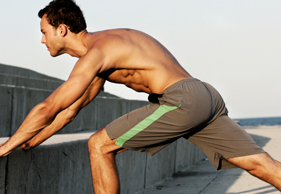Muscle cramps are involuntary and forceful muscle contractions which can be very painful and have a serious effect on your running performance. Keep in mind there are many different types of muscle cramps; the type that athletes often experience can be classified as ‘true’ or ‘exertional’ cramps, and are usually associated with vigorous activity and muscle fatigue.
WHY DO WE CRAMP?
The exact cause of cramping is still being debated and it is not clear why some athletes are more prone to cramping than others. For years we have believed that dehydration and electrolyte (potassium, sodium and magnesium) depletion is to be blamed for muscle cramps during and after strenuous exercise. Yes, sufficient hydration is important to maintain blood volume and to prevent increase in body temperature, and electrolyte levels need to be maintained in order to carry the electrical impulses that make our muscles (including the heart) contract. So dehydration and electrolyte depletion will definitely affect performance, and can even be life-threatening in extreme circumstances, but it has never been proven to be the direct cause of muscle cramps.
Another theory is that the depletion of glycogen (energy stored in the muscle) can lead to muscle cramps. A muscle needs energy to contract as well as to relax. After 60 to 90 minutes of exercise, glycogen stores will be depleted and the muscle will lose its ability to relax, which may contribute to cramping. Although carbohydrate intake during exercise will not prevent cramping, it is important for performance.
So why do muscles cramp? The main cause of muscle cramps seems to be altered neuromuscular control. The body has its own little ‘tension meters’ built into the tendons (that connect muscle to bone) called the Golgi-tendon organs (GTO). When a muscle contracts, the tension in the tendon increases and is registered by the GTO. When the tension increases too much, the GTO sends a message to the brain for the muscle to relax. This reflex protects the tendon from injury and the muscle from cramping.
Muscle fatigue caused by too high intensity, too high volume, or doing activities that your body is not used to, can cause the Golgi-tendon reflex to fail and the muscle will cramp. Continuous activity with the muscle in a shortened position will also lead to failure of the reflex.
HOW DO I PREVENT CRAMPING?
Since there is no single cause of cramping, there is no single prevention or cure. Different athletes may also cramp because of different reasons, so your best chance of preventing cramps will be to address every possible cause.
• Drink sufficient fluid before, during and after a training session or race.
• Make sure that your drinks/snacks contain enough electrolytes. Include salty snacks during your run.
• Maintain glycogen stores by consuming enough carbohydrates before, during and after a training session or race.
• Follow a good stretching routine. Include PNF (proprioceptive neuromuscular facilitation) stretches, to stretch the tendon and facilitate the Golgi-tendon reflex. A biokineticist can design the correct stretching programme and teach you the correct technique.
• Make sure that you are prepared for your event. Your training programme should prepare you for the intensity and length of the race.
• Faulty posture and biomechanics (the way you move and run) may lead to muscles being in a shortened position for a prolonged period of time, which may lead to cramping. A biokineticist can identify this and prescribe exercises to correct posture and biomechanics.
WHAT TO DO WHEN YOU CRAMP
To stop a cramp, you have to decrease intensity so that the Golgi-tendon reflex can function efficiently. Once the cramp has relieved, you can slowly increase intensity again.
Gentle stretching, including proprioneuromuscular (PNF) techniques of the cramping muscle might help to release it. Take note that fast and vigorous stretching can lead to injury. HEre’s how to do PNF stretches:
• Gently stretch the muscle for about 10 seconds. Now contract that same muscle for 8 seconds, followed by another 10 seconds of stretch. Repeat three times.
• As an example, stretch your hamstring by placing your foot up on a bench, keep your knee straight and stretch forward. Contract the hamstring by pushing down on the bench.
A STITICH IS A CRAMP TOO!
A stitch is a cramp of the diaphragm, the muscle under your lungs responsible for breathing. To relieve the cramp, the muscle needs to be stretched. Breathing all the air out of your lungs will stretch the diaphragm and the stitch will go away.
If all else fails, remember some athletes believe that biting your upper lip will make the cramp go away. I’m not so sure if there is any scientific evidence to back this theory up, but you are welcome to try it!
Modern Athlete Expert
Patricia Gouws is a sports scientist and biokineticist in private practice in Bedfordview, Johannesburg. She focuses on wellness, rehabilitation of injuries, injury prevention and sport performance. Patricia is a competitive runner, cyclist and triathlete.


